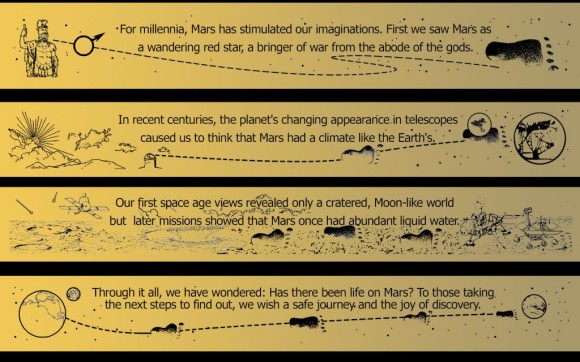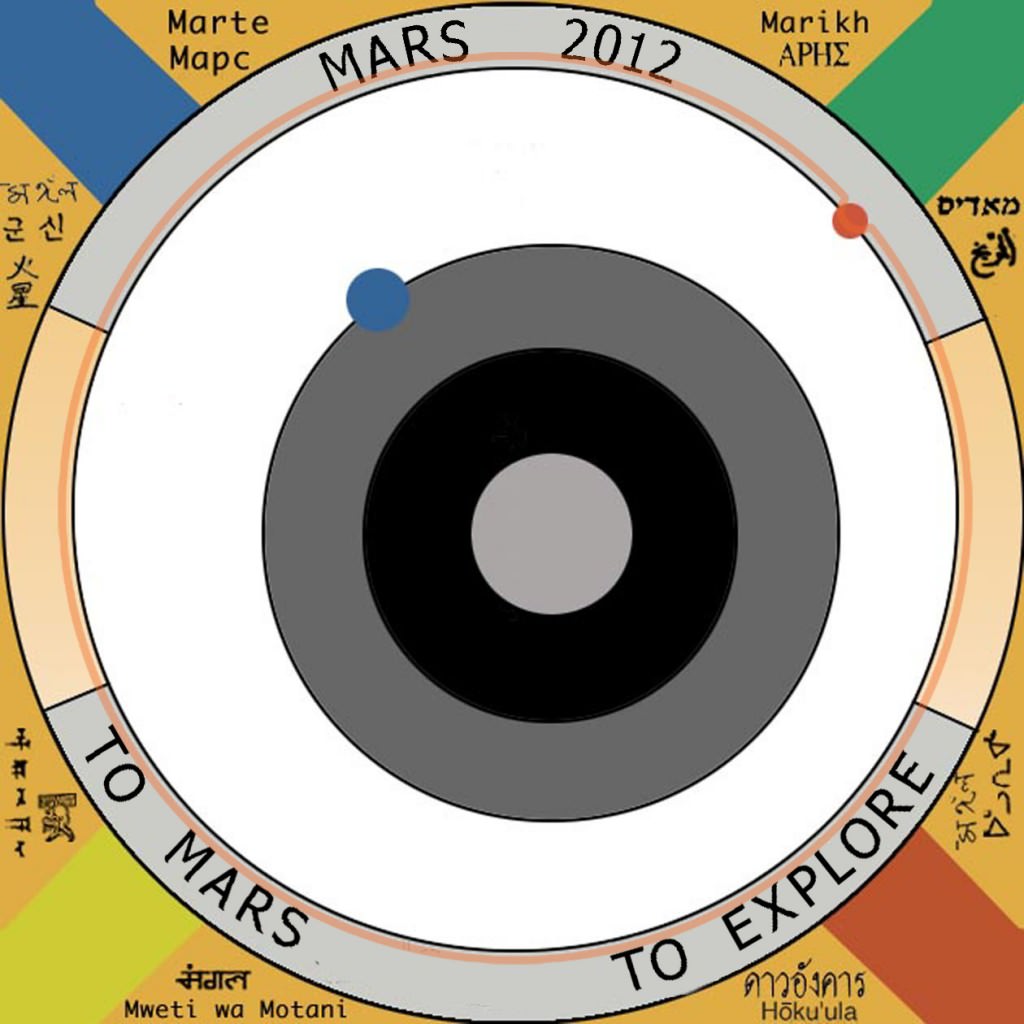[/caption]
There’s been a lot of artifacts sent to the surface of Mars – and now there’s about to be another one left for future generations to discover. Artist Jon Lomberg has collaborated with a team of space scientists to design a sundial which sports edges with designs and images. These embellishments have been authored by Jim Bell and the MER sundial team with the graphics designed by Lomberg.
The upcoming scientific mission to Mars – the Mars Science Laboratory – rover is called Curiosity. Much like its forerunners, NASA’s Mars Exploration Rovers Spirit and Opportunity, the planned sundial will also act as a camera calibration target for the Mastcam camera. Developed by Malin Space Science Systems, inc. of San Diego, CA, the Mastcam camera will be the rover’s principal instrument for photographing the Martian surface. It was developed under the supervision of Principal Investigator Michael Malin and the calibration target will become an outstanding educational opportunity for students. How? The image of the sundial can be transmitted back to Earth, where watchers can engage themselves with how such simple tools can be used to pinpoint times, dates, seasons and even latitudes on Mars. This celebration of space exploration is further cemented by the artistry contained on the “face” of the sundial – the word for Mars written in sixteen languages, including ancient Sumerian, Mayan, Inuktitut, and Hawaiian.
The original idea for this creative educational experience came from Bill Nye The Science Guy, who is currently the Executive Director of The Planetary Society. The message comes from Planetary Society President, Professor James Bell, who is also the MER imaging scientist and leader of the team which included Lomberg to design the sundial and its message. However, don’t think the message was designed for aliens! This time the artwork was intended for future generations of “Martians” – human beings who may one day explore or inhabit Mars. It might be within our lifetimes and it might be centuries from now, but perhaps some day an explorer will encounter what we’ve left behind. This is truly the target audience the message is being left for – but we can only hope they understand English, the primary language of the nation from where the probe originated. The illustrations are simple and elegant – an attempt to show mankind’s involvement with Mars. It combines classic illustrations of the god Ares, an astronomer’s interpretation of Mars, the Viking lander and assorted Mars spacecraft. Like the symbolic step on the Moon, the footprints on the Martian soil are meant to evoke the sands of time and our human need to explore.

Both Spirit and Opportunity took similar sundials along for the ride – ones that included Bell and Lomberg on the design team. While the idea was much the same, they were crafted with a different date, motto and message that combined Lomberg’s drawings and children’s art. The same team, including Diane Bollen, Lou Friedman, Sheri Klug, Tyler Nordgren, Bill Nye, Steve Squyres, Larry Stark, Woody Sullivan, and Aileen Yingst, also provided input on Curiosity’s new message. Jim Bell is a planetary scientist from Arizona State University in Tempe AZ, the Payload Element Lead for the Pancam instruments on Spirit and Opportunity, and President of The Planetary Society in Pasadena, CA and artist Jon Lomberg was Design Director for NASA’s Voyager Golden Record and a long-time collaborator of Carl Sagan. He won an Emmy Award for his work as Chief Artist of the TV series COSMOS.
There are still a lot of credits to go along, though. Lomberg is on his fifth Mars’ message artifact and earlier work includes Russia’s failed Mars 96 mission. As of now, three of Lomberg’s visions have made it to the Red Planet and soon the fifth will be on its way!
Original Story Source: Citizen of the Galaxy.


There are 17 inscriptions but only 16 are different! And why is the Arabic name written in Latin letters? [al-marikh = ??????]
@Lomberg (and Jim Bell?)
I realize now that “Marikh” is the Bahasa and Malay name for Mars (borrowed from Arabic).
But what is ? ?? The Korean name for Mars is ??. Try copy-pasting these two names to Google “images” and see what you get.
Well, ? ? turns out to be Korean for “war god”. Someone must have looked up the name “Mars” in a Korean-English dictionary and jotted down the first thing they saw.
A lot of people have worked very hard to get the science and the engineering of MSL just right. Why not the linguistic and cultural elements?